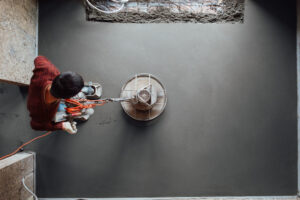Introduction to Concrete Flooring: A Cost-Effective and Durable Choice
Introduce concrete flooring, emphasizing its affordability, durability, and versatility. This section will set the stage for discussing enhancement techniques like polishing, staining, and dying, highlighting concrete’s increasing popularity in residential and commercial spaces.
The Advantages of Polished Concrete
Explore the benefits of polishing concrete, how it transforms the material, and its contribution to aesthetics and functionality. Discuss the process of polishing, its impact on the longevity and maintenance of the floor, and its suitability for various environments.
Concrete Staining vs. Dying: Distinguishing the Techniques
Provide a detailed comparison of concrete staining and dying. Discuss the chemical process of staining and how it differs from the physical absorption of dyes. Highlight the unique outcomes each method offers and their best-suited applications.
 Deep Dive into Concrete Staining: Process and Possibilities
Deep Dive into Concrete Staining: Process and Possibilities
Focus on concrete staining, explaining the types of stains available (acid-based and water-based), the resulting aesthetics, and suitable settings for their application. Explore the natural-looking finishes possible and their appeal in different design contexts.
Exploring Concrete Dying: Versatility and Color Options
Delve into concrete dying, including the variety of dyes available, their application methods, and their best-suited use cases. Discuss the wide range of colors and effects achievable, and the considerations for using dyes in interior versus exterior projects.
How to Choose Between Staining and Dying for Your Project
Offer guidance on selecting between staining and dying based on project requirements. Discuss factors such as desired aesthetics, location (indoor/outdoor), and maintenance needs to help readers make informed decisions.
Creative Applications of Stained and Dyed Concrete
Illustrate the creative potential of stained and dyed concrete through examples in residential and commercial settings. Highlight how these techniques can transform spaces and align with various design themes.
Embracing the Versatility of Concrete with Concrete Etc
Conclude by summarizing the benefits and versatility of concrete flooring. Provide a call to action, inviting readers to consider Concrete Etc for their flooring needs and to explore the possibilities of enhancing concrete floors in their own spaces.
This structure ensures an informative, engaging, and comprehensive article, thoroughly covering the aspects of concrete flooring, its enhancement methods, and their practical applications.


 Deep Dive into Concrete Staining: Process and Possibilities
Deep Dive into Concrete Staining: Process and Possibilities